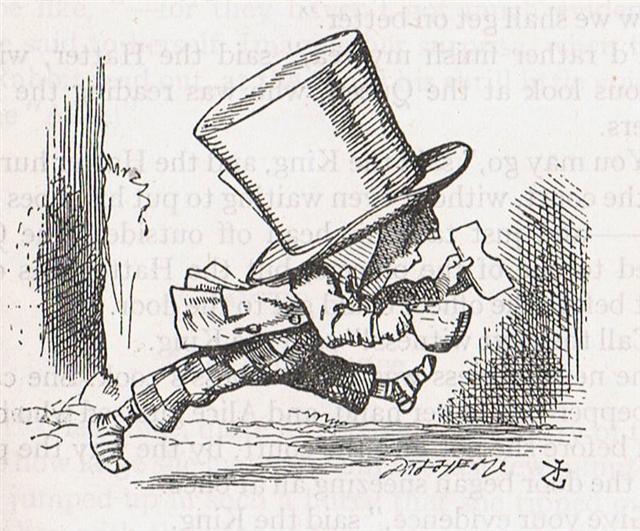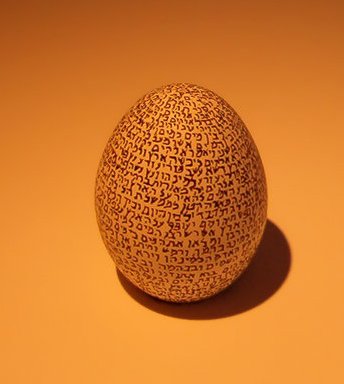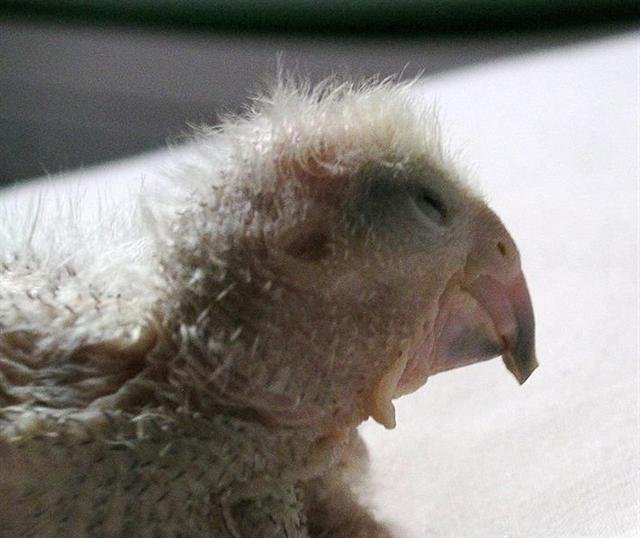523. We have seen how number 29 - probably referring to Mercury - was used in the Tahua (A) text for structural purposes:
Because day 1 was 4 weeks earlier and because the beginning of counting was with number 1. Viri in Ab1-1 is smaller than the other 3 and Metoro began reading the Tahua text at the beginning of side b (the back side of the tablet).
And the quickly running Mad Hatter was evidently much too small for his just inherited hat:
... The name of the tree-felling captain and pilot, Hiro, probably alluded to the planet Mercury - who behaved whimsically (unstable like a liquid) and who was hard to catch sight of because he never stood high in the sky ... Mercury was used in the process of curing pelts for hats, making it impossible for hatters to avoid inhaling the mercury fumes given off during the hat making process; hatters and mill workers thus often suffered mercury poisoning, causing neurological damage, including confused speech and distorted vision ... As to number 26 = (354 + 400) / 29 it seems to refer to the 'surface of the earth':
... Among the Nahyssan of S. Carolina time was measured and a rude chronology arranged by means of strings of leather with knots of various colour, like the Peruvian quipos. The Dakota use a circle as the symbol of time, a smaller one for a year and a larger one for a longer period: the circles are arranged in rows, thus: OOO or O-O-O. The Pima of Arizona make use of a tally. The year-mark is a deep notch across the stick ... We can also count 26 * 26000 (= the precessional cycle) / 365.25 (the Julian year) = ca 26 * 71 = 26 * (100 - 29) = 1846 in order to find a good approximation for my suggested epoch of rongorongo (1842 AD). At this time Polaris (together with Baten Kaitos and Metallah) determined the right ascension line for *26:
... Ecclesiastically, the equinox is reckoned to be on 21 March (even though the equinox occurs, astronomically speaking, on 20 March in most years) ... The surface of Mother Earth conceived of as a Turtle (Honu) measured 7, it was said, and 7 * 26 = 182 (= 364 / 2): ... An iconographic study by Jeff Kowalski suggests a cosmological layout for the Nunnery. The higher placement of the North Building, with its 13 exterior doorways (reflecting the 13 layers of heaven), and the celestial serpents surmounting the huts identify it with the celestial sphere. The iconography of the West Building, with 7 exterior doorways (7 is the mystic number of the earth's surface), and figures of Pawahtun - the earth god as a turtle - indicate this to be the Middleworld, the place of the sun's descent into the Underworld. The East Building has mosaic elements reflecting the old war cult of Teotihuacan, where tradition had it that the sun was born; thus, this may also be Middleworld, the place of the rising sun. Finally, the South Building has 9 exterior doorways (the Underworld or Xibalba had 9 layers), and has the lowest placement in the compex; it thus seems to be associated with death and the nether regions ... 13(0) + 7(0) + 9(0) = 29(0).
And possibly we should recognize that 13 * 5 + 7 * 26 + 9 * 21 = 429 = 13 * 33.
29 meant 'fucking time': ... The Moon was visible for 29 nights, and then her back side (●) was bathed in the vitalizing rays from Tane, making her grow (tupu) once again ... ... When the new moon appeared women assembled and bewailed those who had died since the last one, uttering the following lament: 'Alas! O moon! Thou has returned to life, but our departed beloved ones have not. Thou has bathed in the waiora a Tane, and had thy life renewed, but there is no fount to restore life to our departed ones. Alas ... ... The horizon in the east was ruled by Mercury (never seen anywhere else than close to the surface of Mother Earth), and his orbit looked like a nest of strings: ... Ganz ähnlich is der Name 'Gott von Duazag' des Gottes Nabū ... zu erklären. Er bezeichnet ihn als den Gott des Wachtstums, welches als aus dem Osten stammend betrachtet wird, weil die Sonne, die das Wachstum bringt, im Osten aufgeht. Dass aber Nabū als Ost-Gott aufgefasst wurde, hängt damit zusammen, dass sein Stern, der Mercur, nur im Osten oder Westen sichtbar ist ... The orbit of Mercury had evidently been designed to be in contact with that of Mother Earth:
... The correct length of a year is ... approximately 365¼ - 3 / 400 = 365.2425 days ...
... The name of the tree-felling captain and pilot, Hiro, probably alluded to the planet Mercury - who behaved whimsically (unstable like a liquid) and who was hard to catch sight of because he never stood high in the sky ... Mercury was used in the process of curing pelts for hats, making it impossible for hatters to avoid inhaling the mercury fumes given off during the hat making process; hatters and mill workers thus often suffered mercury poisoning, causing neurological damage, including confused speech and distorted vision ...
|
|||||||||||||||||||||||||||||||||||||||||||||||||||||||||||||||||||||||||||||||||||||||||||||||||||||||||||||||||||||||||||||||||||||||||||||||||||||||||||||||||||||||||||||||||||||||||||||||||||||||||||||||||||||||















